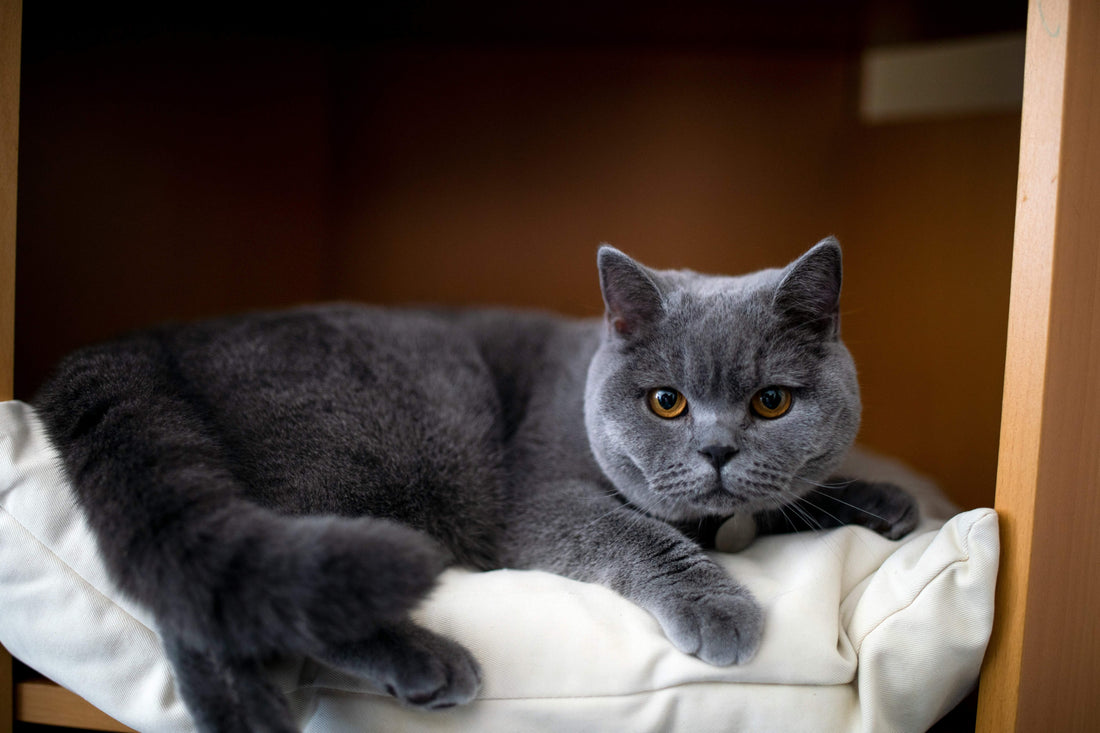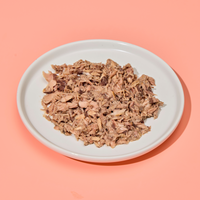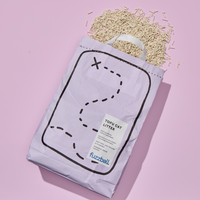10 Tips for New British Shorthair Owners

British Shorthairs are one of the most popular cat breeds in the UK, and for good reason. With their soft coats, round faces, and famously calm nature, they’re often seen as the perfect companion for families and first-time cat owners alike. But before bringing one home, it’s worth knowing what makes them such a good fit and what health and care considerations come with the breed.
Are British Shorthairs Good For First-Time Cat Owners?
Known for their gentle, relaxed and easy-going temperament, British Shorthairs are a great choice for first-time cat owners. Whilst they are affectionate and love the attention of their owners, they are also independent and are perfectly content to spend their time lounging around the house, making them a great choice for a low-maintenance family pet. As a bonus, they are also typically good with children and are not particularly vocal.
British Shorthairs are also considered an adaptable breed, meaning they adapt well to various living conditions. They are equally comfortable in a family home or in an apartment - provided, of course, that they have enough time to play and get all the attention they need. British Shorthairs typically work well with a routine; however, they are also really good at adapting to any changes in schedule, making them an ideal pet for people with many different lifestyles.

Health Problems to Watch Out For With British Shorthair Cats
British Shorthairs are a generally healthy breed of cat, but can be prone to some genetic conditions. These can include;
- Hypertrophic Cardiomyopathy (HCM)
- Polycystic Kidney Disease (PKD)
- Obesity
Hyperthropic Cardiomyopathy is the most common form of heart disease in cats. HCM occurs when there is an increase in the thickness of the muscular wall of the heart, which makes it more difficult for the heart to pump blood properly.
Polycystic Kidney Disease causes the formation of fluid-filled cysts in the kidneys, which grow, damaging the kidneys and potentially leading to kidney failure.
Obesity can be an issue with British Shorthairs. As many of them are indoor cats, they typically burn fewer calories via exercise than an outdoor cat might. That and their tendency to enjoy lazing around mean this is one to watch out for.
There are other things to look out for, including Urinary Tract Issues, Cataracts and Arthritis. It is important to feed a balanced and nutritious diet to prevent weight-related issues and make sure to take regular visits to the vet for vaccinations and check-ups, as with most health problems, early detection is crucial for effective management.
|
Issue |
What it is |
What to do about it |
|
HCM |
Thickening of the wall of the heart making it more difficult to pump blood. |
Regular check-ups at the vet |
|
PKD |
Cysts on the kidneys that grow over time |
Choose a breeder that screens for PKD. |
|
Obesity |
Weight gain from overeating and low activity levels. |
Feed a high-protein wet food that contains no fillers or sugars. Encourage daily play. |
|
Urinary Issues |
Infections or bladder crystals. |
Feed a high-protein wet food and ensure constant access to fresh drinking water. |
|
Cataracts |
Cloudy eyes. |
Watch for any changes in your cat's vision and discuss with your vet |
|
Arthritis |
Joint stiffness or pain. This is more common in older cats.. |
Maintain a healthy weight. |

Ten Tips For British Shorthair Owners
Looking after a British Shorthair is simple once you know what they need. From diet and grooming to playtime and health checks, a few small habits go a long way. Here are ten tips to help your British Shorthair thrive.
Groom Regularly, Even With Short Hair
British Shorthairs should be brushed once or twice a week (you may want to increase the frequency during shedding season). Brushing your cat is really important for maintaining your cat's coat's health. Regular brushing helps to distribute their natural oils, prevents matting and minimises hairballs. Alongside brushing, it is also important to trim your cat's nails, brush their teeth and clean their ears regularly.
Choose a High-Quality Diet
It is important to feed your British Shorthair a diet that is suited to its lifestyle. A high-protein, high-meat content diet provides the amino acids required to build and maintain muscle mass and a healthy weight. Due to their less active habit, it is also important to steer clear of foods that provide little nutritional value, such as carbohydrates. A high-quality diet also enhances coat and skin health, whilst supporting your British Shorthair's digestive system.
Provide Stimulation
Although they are known for their relaxed and gentle personalities, British Shorthairs still require both physical and mental stimulation. Anything from feather wands and laser pointers to feeding puzzles and toys works well. It is also important that your British Shorthair lives in a stimulating environment - think cat trees, scratching posts and plenty of places for them to hide out.
Keep Them Indoors Or Provide Supervised Walks
British Shorthairs are primarily suited to living indoors, although some do enjoy a mix of indoors and outdoors. British Shorthairs are not particularly fast or agile, making them very vulnerable to both predators and traffic. Keeping them inside can therefore offer them some additional protection. You can always take them on a supervised walk or into the garden if you want to give them some fresh air.
Stay On Top Of Vet Care
It is important to stay on top of vet care due to the British Shorthair's predisposition to health issues, such as heart and kidney disease. Regular check-ups at the vet will allow for early detection and treatment of any possible issues.
Choose Cat Furniture That Matches Their Size
When choosing your cat trees, scratch poles, etc, it is important to consider the size of your British Shorthair. Make sure the furniture you choose is both sturdy and stable and is large enough for your cat to stretch out and relax comfortably.
Watch Their Weight
Due to their indoor lifestyle and preponderance for lazing around, it is important to keep an eye on your British Shorthair's weight. A high-quality, high-protein diet can help with this, acting as a natural weight management solution. Avoid food that has little to no nutritional value.
Provide Access to Good Hiding Spots
Just as with all cats, hiding spots provide a sense of comfort and security to British Shorthairs. Hiding spots help cats cope with stress and give them a space to escape from noise or commotion. British Shorthairs also love their personal space - so a good hiding spot to escape from it all is essential.
Use a Wide and Shallow Food Bowl
British Shorthairs have large, round and relatively flat faces. This can make it challenging for them to eat from a deeper bowl. Cats also have very sensitive whiskers; if their whiskers are constantly touching the side of their bowl, it can cause them discomfort, and they may even stop eating. A wide and shallow bowl means they can eat in comfort, making mealtimes more enjoyable.
Introduce Changes Gradually
Due to their naturally cautious behaviour, it is important to introduce any changes to your British Shorthairs' lifestyle in a slow and gentle manner. Allowing your cat to adapt to changes at its own pace, we’ll allow them to feel safe and secure rather than overwhelmed and threatened.

Are British Shorthairs Hyperallergenic?
British Shorthairs may shed less than other breeds, but this does not make them hypoallergenic. The allergens produced by cats are in their saliva and dander (dry skin), which essentially means that no cats are truly hypoallergenic. It is important to note that different people will have different reactions and may be more sensitive to some cats than others.
What Food Should British Shorthairs Avoid?
Due to their somewhat more relaxed lifestyles, obesity can be an issue for British Shorthairs. It is therefore important to avoid feeding them foods that are full of carbohydrates like grains and starchy vegetables, as well as foods containing sugar. Avoid feeding cheap kibble that is often filled with unnecessary fillers and ingredients that are difficult to digest.
Fuzzball's wet food is a perfect example of what you should be feeding your British Shorthair, high in protein, full of whole meats and containing no fillers or sugar - this food gives your cats all the nutrients they need to maintain a healthy lifestyle. Fuzzball’s grain-free, high-protein kibble is also a great option if this is easier for you to feed.
How Often Should You Bathe Your British Shorthair?
If your British Shorthair is healthy, there is no reason to bathe your cat. Most cats do not enjoy being washed and do not tolerate it well. British Shorthairs are known to be good at grooming themselves, so there is no real need to wash them.
Baths should be reserved for very specific occasions, like when your cat has rolled in the dirt or is particularly smelly. If you are going to give your cat a bath, make sure you use lukewarm water, a cat-specific shampoo and avoid getting water in their eyes and ears. Also, make sure to rinse all the soap out regularly.
So, are British Shorthairs a good pick for first-time cat owners? Absolutely. British Shorthairs are easygoing, affectionate, and a great match for most homes. With the right diet, regular grooming, and a bit of play, they’ll stay healthy and happy for years to come. Give them a cosy spot, a good routine, and you’ll have a very content cat on your hands.






